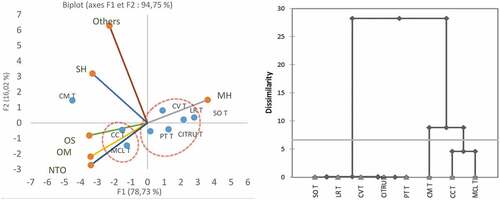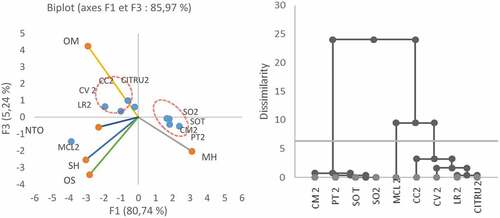ABSTRACT
‘Maltaise demi sanguine’ cultivars are usually grafted on sour orange rootstock. Nonetheless, this rootstock is highly susceptible to Citrus tristeza virus (CTV). A trial was set up in order to present new rootstocks as an alternative to sour orange. The effects of eight citrus rootstocks upon the volatile flavor components of the “Maltaise demi sanguine” peel were investigated in both healthy plants and those inoculated with Citrus exocortis viroid (CEVd) and Hop stunt viroid (HSVd). Rootstocks and viroid infection had no significant effect on essential oil yields. Oil components were analyzed by GC-MS. Total of 69 compounds were identified, representing 99% of the total oil. Limonene was the major component in all samples (59.53–95.34%). Principal components and hierarchical cluster analyses revealed that essential oils from plants grafted on Alemow and Carrizo citrange showed the most variable compositions in cases of healthy plants and those inoculated with CEVd. For those plants infected by HSVd, Cleopatra mandarin seemed to be the most affected. Overall, the combined effect of CEVd infection and the use of rootstocks Alemow, Carrizo citrange, and Volkamer lemon had the most pronounced chemical variability.
Introduction
Citrus production in Tunisia is economically important and extends over 24,000 ha. Several citrus varieties are cultivated: the “Maltaise demi sanguine” variety (30%), followed by navel oranges (24%), clementines (16%), lemon trees (15%), and 15% of less important varieties (Mandarins, Valencia late, etc.).[Citation1] Sour orange (C. aurantium L.) is the main rootstock used because of its excellent adaptation to local conditions. However, it is well known that trees grafted on sour orange are sensitive to Citrustristeza virus (CTV), and this virus has killed about 100 million citrus trees propagated on this rootstock around the world.[Citation2] Considering the drastic effects of such disease, substitution of sour orange by tolerant rootstock becomes a necessity in the Tunisian production system of citrus. However, some new rootstocks may be sensitive to viroids.[Citation3]
Viroids are small, circular, single-stranded RNA pathogens that cause diseases of economic importance in several crops.[Citation4] Viroids are heavily present in Tunisian citrus orchards and should be considered in the integrated pest management strategies.[Citation5] The most important prevailing viroids are: Citrus exocortis viroid (CEVd) and specific variants of Hop stunt viroid (HSVd) (CVd-IIb and CVd-IIc). These two viroids are the causal agents of two well-known citrus diseases exocortis and cachexia, respectively,[Citation5] that reduces fruit quantity and quality. As fruit production is a determinant criterion, fruit quality is also important for consumers regarding organoleptic characteristics or other secondary metabolites, vitamins, etc. However, citrus fruit peel is known to contain a large amount of essential oils whose importance is generally appreciated. This high added-value product accumulates in the flavedo, leaves or flower petals.[Citation6] Citrus peel essential oils are an abundant source of oxygenated terpenes which are of interest to many industrial sectors, e.g., food, pharmacy, cosmetics, flavor, and perfumes industries.[Citation7] The composition and yield of essential oils of the citrus fruit peels may be affected by infectious agents such as viroids. It is also known that rootstocks affect the agronomic and qualitative performance of fruit production in citrus. The question is whether it would be the same for essential oils. This study reports for the first time the chemical investigations on Maltaise peel oils with double effect of rootstock and viroids on the production of aroma volatiles.
Material and methods
Plant material and infectious agents
This study was held on essential oils of the fruit peel of the famous Tunisian sweet orange variety” Maltaise demi-sanguine” (Citrus sinensis). Investigations concerned the influence of the used rootstocks species and the infectious viroids that were inoculated to these rootstocks. Eight rootstocks were selected for this assay included: Sour orange (SO), Alemow (C. macrophylla Webster) (CM), Carrizo citrange (CC), Volkamer lemon (C. Volkameriana Ten. and Pasq.) (CV), Cleopatra mandarin (C. reshni Hort. ex Tan.) (MCL), Swingle citrumelo 4475 (Citru), Rangpur lime (C. limonia Osb.) (LR) and trifoliate orange (Poncirus trifoliata Raf.) (PT).
Viroids used for inoculation are the most prevailing in Tunisia citrus orchards: Citrus exocortis viroid (CEVd), Hop stunt viroid (HSVd) (variant CVIId-b). Besides healthy treatments (T), each rootstock was inoculated with CEVd = 1 and HSVd = 2. A total of 24 treatments were randomly distributed in the split-plot experimental design. Sampling only concerned 23 treatments, since no fruits were produced by PT (1).
Essential oil extraction
Essential oils were extracted using the hydrodistillation method. For each studied rootstocks, open-air dried Maltaise fruit peels were introduced into a one liter flask and impregnated with distilled water with the ratio (1/10)(For (100 g) of dry plant material was subjected to hydrodistillation (1 L) of distillated water was added to the balloon of Clevenger-type apparatus). The mixture was heated under boiling for 180 min using an electric heater. Obtained extracts were dried over anhydrous sodium sulfate Na2SO4 and stored at 6◦C in darkness until analyzed.[Citation8]
Essential oils composition
The GC-MS analysis of essential oil volatile components were performed using a Hewlett-Packard 6890 series GC system (Agilent Technologies, Madrid, Spain) coupled to a quadruple mass spectrometer (model HP 5973) equipped with a non-polar RESTEK RTX5MS capillary column (5% phenyl 95% methy polysiloxane: (30 m x 0.25 mm, 0.25 μm film thickness)). For GC-MS detection, an electron ionization system with ionization energy of 70 eV was used over a scan range of 23–300 atomic mass units (amu). Helium was the carrier gas, at a flow rate of 1 mL/min and in constant pressure of 70 kPa. Injector and detector MS transfer line temperatures were set at 250°C and 150°C, respectively; the temperature of the ion source was 220°C.
The column temperature was programmed to rise from 60°C to 200°C at a rate of 3°C/min then from 200°C to 250°C at the rate of 10°C/min and finally maintained at constant temperature for 30 min. The volume of injections was 0.20 μL of a hexane-oil solution, injected in the split mode.The injector temperature was 220°C and the oven temperature was programmed to rise from 60°C to 200°C at a rate of 3°C/min then from 200°C to 250°C at the rate of 10°C/min. Injector and MS transfer line temperatures were set at 250°C and 150°C, respectively, and in constant pressure of 70 kPa. Diluted samples in ethyl ether, of 1 μL were injected in the split mode (30 ml/min).
Identification of compounds
For all cultivars, the quantitative composition was calculated as a relative percentage of peak area and oil components were identified by calculating of their retention indices under temperature-programmed conditions for n-alkanes (C8–C20) and the oil on an RTX5MS column under the same chromatographic conditions. Identification of individual compounds was based on the NIST05 database and confirmed by comparison of their retention indices with authentic compounds or with those reported in the literature.[Citation9] The relative percentage of the oil constituents was determined by normalization from the GC peak areas, assuming identical mass response factor for all compounds: (% Ci = Si/Stotal) with (%Ci = percent of analyt/Si = Surface of pic area of Ci/Stotal = total surface of all pics). For all samples, 5 μL of essential oil (HE) were diluted in 1 mL of ethyl ether (Et2O).In all figures, abbreviations were in use: (MH: Monoterpenes hydrocarbons, OM: Oxygenated monoterpenes, SH: Sesquiterpene hydrocarbons, OS: Oxygenated sesquiterpenes, NTO: Non-terpenic oxygenated compounds).
Statistical analysis
ANOVA was applied, where values of p ≤ 0.05 were considered to be statistically significant for verifying the chemical variability of the compounds in the essential oils identified in the samples. Data analyses were performed using principal component analysis (PCA) and hierarchical cluster analysis (HCA). Both methods aim at reducing the multivariate space in which objects (oil samples) are distributed, but are complementary in their ability to present results.[Citation10] PCA provides the data for plots in which both objects (oil samples) and variables (chemical classes or oil components) are represented, while a dendrogram was produced by HCA using a method of hierarchical clustering, based on Euclidean distances between pairs of oil samples. The PCA was carried out using the function PCA of XLSTAT 2014 and the statistical R software (R Foundation, Institute for Statistics and Mathematics, Austria).
Results and discussion
Variability of citrus peel essential oil yield
The average yield of essential oil for each sample on different rootstocks from healthy trees (T), trees inoculated with CEVd viroid (1) and those inoculated with HSVd viroid (2) are shown in . The oil yield in mg/100 g of dried matter varied from 0.386% to 0.835%. The lowest one (0.386%) was for CM1, while the highest (0.835%) was recorded for Citru T.
Table 1. Yields (% w/w on dry weight basis) of ‘Maltaise’ peels oils from trees propagated on eight rootstocks non-inoculated (T), inoculated with CEVd (1) or HSVd (2)
The results of the variance analysis of the presented data showed no significant differences (p > 0.05) between treatments indicate that rootstocks as well as the viroids infection, had no significant effect on the yield of essential oil for all samples excepting the healthy and grafted on “CITRU” rootstock. This result is confirmed by ANOVA test that has mentioned that only this latter rootstock has p = 0.007 < 0.05. However, Kesteson et al.[Citation11] had studied the effect of different rootstocks on the lemons essential oil yields and they reported that no significant differences were found in the yield of peel oil from lemon budwood on seven different rootstocks also Verzera et al.[Citation12] had confirmed that the essential oil yield of Bergamot has not been influenced by rootstocks.
Chemical composition
GC-MS analysis of different Maltaise peel essential oils extracted by hydrodistillation made it possible to identify 69 compounds from all of the samples making up over 99% of the total oil. Most of the 69 compounds identified were present in low amounts; nevertheless, 17 major ones, which accounted for over 1% of total volatiles, were observed in at least one citrus sinensis peel sample, as shown in (). Our data showed that, on one hand, Monoterpene hydrocarbons were the most represented class in all samples whereas other substances were present in large numbers, but in lower amounts in almost all cultivars. Secondly, Limonene was the major compound in all oil samples, ranging from 59.53% to 95.34%, followed by β-pinene (0.89–2.09%), linalool (0.41–7.21%) and terpinen-4-ol (0.49–4.39%), which is in agreement with results previously found in the literature.[Citation13] In the case of our control SOT (traditional Maltaise), the essential oil was found to be dominated by Limonene (93.34%) followed by β-pinene (1.48%) and terpinen-4-ol (1.42%). Similar findings have been reported by Hosni et al.[Citation14]; however, terpinen-4-ol was not detected in their oil.
Table 2. Chemical composition of ‘Maltaise’ peels from trees propogated on different rootstocks non-inoculated (T) or inoculated with two viroids CEVd (1) and HSVd (2)
These observations could indicate that the different compositions may be due to differences in biosynthetic pathways which can be influenced by rootstocks and viroid infection since all cultivars shared the same environmental, cultural and soil conditions.[Citation14] In order to better understand the variation in the composition of essential oils both as a function of the rootstock and as a function of the treatment (viroid infection), each individual effect was studied.
Effect of rootstock/scion combinations on chemical composition
At 5% risk, rootstocks and viroid infections had a significant influence on the essential oil composition (p < 0.05). For healthy trees (treatment T), we examined the effect of rootstocks on the volatile aroma composition of healthy trees and we noted that the level of monoterpenes decreased for all cultivars meanwhile, the level of other classes of chemical compounds increased. PCA and HCA were applied to identify the possible relationship between citrus peel essential oil compositions and the variation of rootstocks; PCA confirms the results of HCA and highlights the main qualitative and quantitative differences between the groups as shown in
In fact, statistical analysis differentiated three groups. Cluster I included LR, CV, PT, and Citru, whose composition is very similar to that of the traditional rootstock SO and quantities of monoterpenes (exclusively Limonene) in all samples exceeded 85%. Cluster II, consisting of MCL and CC, had essential oils characterized by strong homogeneity and display: monoterpenes at about 81% and oxygenated monoterpenes around 12.5%.CM had a distinctive composition with 72% monoterpenes, 13% oxygenated monoterpenes, and3% oxygenated sesquiterpenes. From this, we can conclude that, for healthy trees, the grafted cultivars on CM, CC, and MCL are more influenced by the chemical classes present in the citrus peel essential oil.
For cultivars on trees inoculated with CEVd viroid (1), DATA processing aimed at classifying and grouping samples based on their essential oil chemical classes as illustrated in . The statistical analysis allotted three groups: the first, which included Citru, LR, MCL, and SO, was made up of more than 93% of monoterpene hydrocarbons, with a composition very similar to SOT, CV and CC were in the same clump since their essential oils are characterized by similar
Figure 2. PCA and Dendrogram of Maltaise peel oil samples from trees inoculated by CEVd propagated on 8 rootstocks
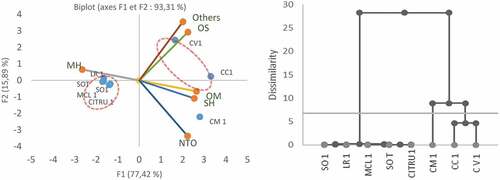
The level of oxygenated sesquiterpenes (eudesm-7(11)-en-4-ol and Nootkatone) as well as the presence of C 16:0 acid as a characteristic compound in these two samples. For both treatments 1 and 2, the essential oil of the peels of the fruits grafted on CM showed a considerable intragroup variation, since the monoterpene level did not exceed 63%. Oxygenated monoterpenes, mainly comprising linalool, carvone and terpinen-4-ol, reached 25.5%, followed by non-terpenic oxygenated compounds with 6% containing principally the two aldehydes decanal 2.02% and octanal 0.87%.In the case of trees inoculated with CEVd viroid (1) and of eight rootstocks, CM, CV, and CC seemed to have the most influenced essential oil composition.
Overall, the analyzed peel essential oils isolated from cultivars grafted on different rootstocks inoculated with HSVd viroid (2) mainly contained monoterpenes with amounts ranging from 87.65% to 97.81%, followed by oxygenated monoterpenes from 1.65% to 8.34% of the essential oils. Even though intra-variations were minimal for the different essential oils for this treatment, the samples were allotted to three main groups using PCA and HCA (). The first one grouped CM, SO, and PT and had a similar composition to our control SOT. The second was marked by a higher rate of oxygenated monoterpenes, between 6.17% and 8.34%, whereas MCL, the third, stood out due to the presence of sesquiterpenes, oxygenated sesquiterpenes and non-terpenic oxygenated compounds at 1.63%, 1.82%, and 1.46% respectively.
Effect of viroid infections on the composition of essential oil for different rootstocks
The results of the analysis of variance for the data on the classes of compounds of essential oils showed significant differences (p < 0.05) between treatments at a risk of 5%. The histograms illustrated in- showed that infection by CEVd and HSVd had no real effect on the classes of compounds for the oils isolated from the cultivars grafted on SO, LR and Citru. Regarding PT and MCL, there was a slight increase in hydrocarbon monoterpenes in the case of HSVd infection. However, our data reported that for CC, CV, and CM, CEVd infection led to a considerable decrease in the level of monoterpenes and an increase in oxygenated monoterpenes, whereas infection with HSVd led to an increase in monoterpenes compared to essential oils isolated from peels of healthy plants.
Figure 4. Effect of viroids CEVd (1) and HSVd (2) on the chemical composition of Maltaise peels oils from fruits from trees propagated on 8 rootstocks
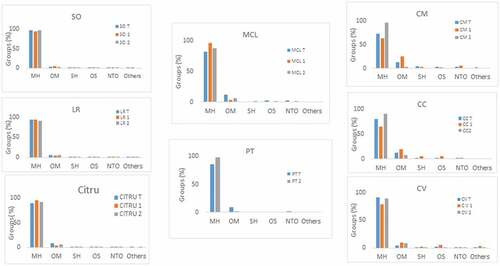
All of these results were confirmed by PCA analysis as shown in . Considering only the composition given by PCA, the greater the area of the ellipse, the greater the influence on the composition; it is obvious that CM, CC, CV, and MCL are the most sensitive rootstocks for infection by viroids in terms of the classes of compounds of Maltaise peel essential oils. These differences seemed to be a consequence of the cytological effect on the mesophyll tissues as a result of viroid infection. There is also a possibility that viroids affect the flavedo of the schizogenous glands but the mechanism of oil biosynthesis in the diseased tissues is still unknown.[Citation15]
Combined effect of rootstock and viroid infection on the chemical composition of different essential oils
In order to understand, the consolidated impact of rootstock/viroid (which has not been studied before to our knowledge), compositions of Maltaise peel oil samples (Citrus sinensis) were submitted to PCA. As it can be observed in and both PCA and cluster analysis demonstrated great variability in the composition of volatile oils and revealed the formation of three groups: Cluster I (CMT, CCT, MCL T, and CV1) characterized by amounts of monoterpenes ranging from 72% to 81%; Cluster II (CM1 and CC1) was characterized by a high content of oxygenated compounds (27.7 −33.3%); and Cluster III which included all others samples and clearly corresponded to the typical chemical composition of Maltaise peel oil, with a high amount of monoterpenes, exclusively Limonene (90–97%).
Figure 6. PCA for the category of compounds of the maltaise peels essential oils from orange trees propagated on eight different rootstocks non-inoculated (T), inoculated with viroids CEVd (1) and HSVd (2)
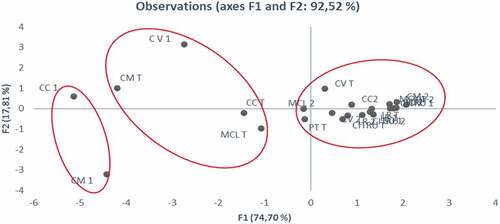
Figure 7. Dendrogram of chemical composition dissimilarity relationships among the ‘Maltaise demi sanguine’ oil samples from trees propagated on eight different rootstocks non-inoculated (T), inoculated with two viroids CEVd (1) and HSVd (2)
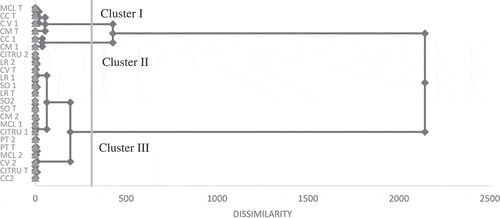
Treatment 2 had no significant impact on the composition of Maltaise essential oils grafted on the eight different rootstocks, whereas the combination of CM, CC, CV, and treatment 1 most influenced essential oils both in their detailed compositions and at the rate of substance classes as well. The reasons for this variation remain unknown, but it can be assumed that CEVd affected the plant glands in their secondary metabolites.[Citation16] In fact, previous studies have reported that some citrus essential oils are reduced in case of infection by CEVd.[Citation16] CC, CM, and MCL gave greater chemical variability of Maltaise essential oils than the control, even in the case of healthy plants. This finding was in contradiction to results obtained by Pedruzzi et al. (2004) who noted that rootstock had no effect on Mandarin essential oils.[Citation17] However, many others have demonstrated that a variation in rootstock may have a profound impact on the amount of oxygenated essential oil compounds in the case of Page Mandarin peel oil and Bergamot essential oil.[Citation16,Citation17]
Conclusion
The present study describes, for the first time, the variability in yield and chemical composition of Citrus sinensis peel essential oils in relation to rootstock and viroid infection. Furthermore, principal component analysis and hierarchical cluster analysis showed significant variations in the composition of essential oil. Rangpur lime(LR) and Swingle citrumelo 4475 (Citru) rootstocks infected or not with CEVd and HSVd did not show any difference with our control sour orange (SOT) especially in terms of monoterpene hydrocarbons where limonene was the most abundant compound. Therefore, since the quality of essential oil can be determined by the amount of their oxygenated compounds, it may be concluded that rootstocks Alemow (CM), Carrizo citrange (CC) and Volkamer lemon (CV) at health state or inoculated with CEVd and also healthy MCL are better candidates for producing these oxygenated compounds which improve the antioxidant activity of the essential oils.
Acknowledgments
This work is part of PRF (Federated Research Project) on Citrus, entitled “Principal Citrus Viruses: Characterization and Integrated Management” and supported by Ministry of Higher Education and Scientific Research of Tunisia (MESRST) and CTA (Technical Centre of Citrus). The authors declare that there are no conflicts of interest.
Additional information
Funding
References
- DGPA: General Direction of Agricultural Production. Annuel report of Ministry of Agriculture of Tunisia. 2015.
- Sano, T.; Barba, M.; Li, S. F.; Hadidi, A. Viroids and RNA Silencing Mechanism, Role in Viroid Pathogenicity and Development of Viroid - Resistant Plants. GM Crops. 2010, 1, 80–86. DOI: 10.4161/gmcr.1.2.11871.
- Roistacher, C. N. Psorosis: A Review. In: Moreno, P., Da Graça, J. V., Timmer, L. W., editors. Proceedings of the 12th International Organisation of Citrus Virologists (IOCV) Conference, Riverside, pp: 139–154, 1993.
- Vila, N. D.; Roistacher, C. N.; Bustamante, R. R.; Semancik, J. S. A Definition of Citrus Viroid Groups and Their Relationship to the Exocortis Disease. J. Gen. Virol. 1988, 69, 3069–3080. DOI: 10.1099/0022-1317-69-12-3069.
- Najar, A.; Vila, N. D. Viroid Prevalence in Tunisia Citrus. Plant Dis. 2004, 88(11), 1286. DOI: 10.1094/PDIS.2004.88.11.1286.
- Huet, R.;. Les huiles essentielles d’agrumes: D. Technologies d’extraction. Fruits. 1991, 46, 551–564.
- Matthews, R. F.; Braddock, R. J. Recovery and Applications of Essential Oils from Oranges. Food Technol. Chicago. 1987, 41, 57–61.
- Bourgou, S.; Rahali, F. Z.; Ourghemmi, I.; Tounsi, M. S. Changes of Peel Essential Oil Composition of Four Tunisian Citrus during Fruit Maturation. Sci.World.J. 2012, 2012, 1–8. DOI: 10.1100/2012/528593.
- McLafferty, F. W.; Stauffer, D. B. The Important Peak Index of the Registry of Mass Spectral Data; John Wiley & son, editor: New York, NY, USA, 1991.
- Massart, D. L.; Vandeginste, B. G. M.; Deming, S. N.; Michotte, Y.; Kaufman, L. Chemometrics: A Text Book; Elsevier: Amsterdam, 1988.
- Kesterson, J. W.; Braddock, R. J.; Koo, R. C. J. The Effect of Budwood, Rootstocks, Rrigation and Fertilization on the Yield of Florida Lemon Oil. Proc. Fla State Hort. Soc. 1974, 87, 6–14.
- Verzera, A.; Trozzi, A. L.; Gazea, F.; Cicciarello, G.; Cotroneo, A. Effects of Rootstock on the Composition of Bergamot (Citrus Bergamia Risso Et Poiteau) Essential Oil. J. Agric. Food Chem. 2003, 51, 206–210. DOI: 10.1021/jf0206872.
- Trozzi, A.; Verzera, A.; Lamonica, G. Essential Oil Composition of Citrus Sinensis (L.) Osbeck Cv. Maltese. J. Essent. Oil Res. 1999, 11, 482–488. DOI: 10.1080/10412905.1999.9701191.
- Azam, M.; Jiang, Q.; Zhang, B.; Xu, C.; Chen, K. Citrus Leaf Volatiles as Affected by Developmental Stage and Genetic Type. Int. J. Mol. Sci. 2003, 14, 17744–17766. 10.3390%2Fijms140917744 DOI: 10.3390/ijms140917744.
- Vekiari, S. A.; Protopapadakis, E. E.; Papadopoulou, P.; Argyriadou, G. N. Variation in the Essential Oils of Citron Leaves and Peel Infected by Exocortis Disease. J. Hortic. Sci. Biotech. 2012, 77(4), 428–431. DOI: 10.1080/14620316.2002.11511516.
- Dvarjazi, B. B.; Rustaiyan, A.; Talaei, A. The Effects of Rootstock on the Volatile Flavour Components of Page Mandarin [(C.Reticulata Var Dancy × C.Paradisi Vardancan) × C.Clemantina] Juice and Peel. Iran. J. Chem. Eng. 2009, 28(2), 99–111.
- Pedruzzi, L.; Serafini, L. A.; Moyna, P. Influence of Rootstock on Essential Oil Composition of Mandarins. Acta Farm Bonaerense. 2004, 23(4), 498–502.

